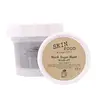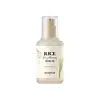What's inside
What's inside
 Key Ingredients
Key Ingredients

 Benefits
Benefits

 Concerns
Concerns

 Ingredients Side-by-side
Ingredients Side-by-side

Sucrose
HumectantPEG-7 Glyceryl Cocoate
EmulsifyingGlycerin
HumectantEuphorbia Cerifera Wax
Macadamia Ternifolia Seed Oil
EmollientCaprylic/Capric Triglyceride
MaskingCetyl Ethylhexanoate
EmollientLanolin
EmollientStearalkonium Hectorite
Gel FormingButyrospermum Parkii Butter
Skin ConditioningLimnanthes Alba Seed Oil
Skin ConditioningCaramel
Cosmetic ColorantSorbitan Laurate
EmulsifyingTocopheryl Acetate
AntioxidantEthylhexylglycerin
Skin ConditioningWater
Skin ConditioningParfum
MaskingSucrose, PEG-7 Glyceryl Cocoate, Glycerin, Euphorbia Cerifera Wax, Macadamia Ternifolia Seed Oil, Caprylic/Capric Triglyceride, Cetyl Ethylhexanoate, Lanolin, Stearalkonium Hectorite, Butyrospermum Parkii Butter, Limnanthes Alba Seed Oil, Caramel, Sorbitan Laurate, Tocopheryl Acetate, Ethylhexylglycerin, Water, Parfum
Water
Skin ConditioningButylene Glycol
HumectantGlycerin
HumectantIsopentyldiol
HumectantPolyglycerin-3
Humectant1,2-Hexanediol
Skin ConditioningNiacinamide
SmoothingCaprylic/Capric Triglyceride
MaskingCetearyl Olivate
Betaine
HumectantAmmonium Acryloyldimethyltaurate/Vp Copolymer
Sorbitan Olivate
EmulsifyingGlyceryl Stearate
EmollientEthylhexylglycerin
Skin ConditioningXanthan Gum
EmulsifyingAdenosine
Skin ConditioningOryza Sativa Extract
AbsorbentOryza Sativa Bran Water
MaskingOryza Sativa Seed Water
AntimicrobialAspergillus Ferment
Skin ConditioningDipotassium Glycyrrhizate
HumectantGlycine
BufferingSerine
MaskingGlutamic Acid
HumectantAspartic Acid
MaskingLeucine
Skin ConditioningAlanine
MaskingLysine
Skin ConditioningArginine
MaskingTyrosine
MaskingPhenylalanine
MaskingProline
Skin ConditioningThreonine
Valine
MaskingIsoleucine
Skin ConditioningHistidine
HumectantMethionine
Skin ConditioningCysteine
AntioxidantHydrolyzed Rice Protein
Skin ConditioningGluconolactone
Skin ConditioningCaprylhydroxamic Acid
Trehalose
HumectantSh-Oligopeptide-1
Skin ConditioningProtease
ExfoliatingDisodium EDTA
Parfum
MaskingWater, Butylene Glycol, Glycerin, Isopentyldiol, Polyglycerin-3, 1,2-Hexanediol, Niacinamide, Caprylic/Capric Triglyceride, Cetearyl Olivate, Betaine, Ammonium Acryloyldimethyltaurate/Vp Copolymer, Sorbitan Olivate, Glyceryl Stearate, Ethylhexylglycerin, Xanthan Gum, Adenosine, Oryza Sativa Extract, Oryza Sativa Bran Water, Oryza Sativa Seed Water, Aspergillus Ferment, Dipotassium Glycyrrhizate, Glycine, Serine, Glutamic Acid, Aspartic Acid, Leucine, Alanine, Lysine, Arginine, Tyrosine, Phenylalanine, Proline, Threonine, Valine, Isoleucine, Histidine, Methionine, Cysteine, Hydrolyzed Rice Protein, Gluconolactone, Caprylhydroxamic Acid, Trehalose, Sh-Oligopeptide-1, Protease, Disodium EDTA, Parfum
 Reviews
Reviews

Ingredients Explained
These ingredients are found in both products.
Ingredients higher up in an ingredient list are typically present in a larger amount.
This ingredient is an emollient, solvent, and texture enhancer. It is considered a skin-softener by helping the skin prevent moisture loss.
It helps thicken a product's formula and makes it easier to spread by dissolving clumping compounds.
Caprylic Triglyceride is made by combining glycerin with coconut oil, forming a clear liquid.
While there is an assumption Caprylic Triglyceride can clog pores due to it being derived from coconut oil, there is no research supporting this.
Learn more about Caprylic/Capric TriglycerideEthylhexylglycerin (we can't pronounce this either) is commonly used as a preservative and skin softener. It is derived from glyceryl.
You might see Ethylhexylglycerin often paired with other preservatives such as phenoxyethanol. Ethylhexylglycerin has been found to increase the effectiveness of these other preservatives.
Glycerin is already naturally found in your skin. It helps moisturize and protect your skin.
A study from 2016 found glycerin to be more effective as a humectant than AHAs and hyaluronic acid.
As a humectant, it helps the skin stay hydrated by pulling moisture to your skin. The low molecular weight of glycerin allows it to pull moisture into the deeper layers of your skin.
Hydrated skin improves your skin barrier; Your skin barrier helps protect against irritants and bacteria.
Glycerin has also been found to have antimicrobial and antiviral properties. Due to these properties, glycerin is often used in wound and burn treatments.
In cosmetics, glycerin is usually derived from plants such as soybean or palm. However, it can also be sourced from animals, such as tallow or animal fat.
This ingredient is organic, colorless, odorless, and non-toxic.
Glycerin is the name for this ingredient in American English. British English uses Glycerol/Glycerine.
Learn more about GlycerinParfum is a catch-all term for an ingredient or more that is used to give a scent to products.
Also called "fragrance", this ingredient can be a blend of hundreds of chemicals or plant oils. This means every product with "fragrance" or "parfum" in the ingredients list is a different mixture.
For instance, Habanolide is a proprietary trade name for a specific aroma chemical. When used as a fragrance ingredient in cosmetics, most aroma chemicals fall under the broad labeling category of “FRAGRANCE” or “PARFUM” according to EU and US regulations.
The term 'parfum' or 'fragrance' is not regulated in many countries. In many cases, it is up to the brand to define this term.
For instance, many brands choose to label themselves as "fragrance-free" because they are not using synthetic fragrances. However, their products may still contain ingredients such as essential oils that are considered a fragrance by INCI standards.
One example is Calendula flower extract. Calendula is an essential oil that still imparts a scent or 'fragrance'.
Depending on the blend, the ingredients in the mixture can cause allergies and sensitivities on the skin. Some ingredients that are known EU allergens include linalool and citronellol.
Parfum can also be used to mask or cover an unpleasant scent.
The bottom line is: not all fragrances/parfum/ingredients are created equally. If you are worried about fragrances, we recommend taking a closer look at an ingredient. And of course, we always recommend speaking with a professional.
Learn more about ParfumWater. It's the most common cosmetic ingredient of all. You'll usually see it at the top of ingredient lists, meaning that it makes up the largest part of the product.
So why is it so popular? Water most often acts as a solvent - this means that it helps dissolve other ingredients into the formulation.
You'll also recognize water as that liquid we all need to stay alive. If you see this, drink a glass of water. Stay hydrated!
Learn more about Water